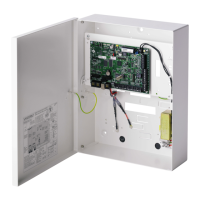Engineer programming via the browser
Installation & Configuration Manual
The SPCP355.300 Smart PSU firmware can only be updated through the
browser. It cannot be upgraded using SPCPro.
The mains power must be connected.
The upgrade procedure can take up to 2 minutes to complete. Do not perform any
actions within the browser, restart or shut down the system until the upgrade
completes. A message will be displayed when the process is complete.
See also
Adding / Editing User Profiles [➙ 186]
17.11.1.2 Upgrading Languages
A custom language file (*.clng) can be uploaded to the panel. This file applies to
the panel firmware only and is not available for SPC Pro or SPC Safe.
The panel must be licensed for use of custom languages and other languages.
To upgrade languages on the system:
1. Select File -> Upgrade.
The Panel Upgrade Operations page is displayed:
2. Select the language file to upgrade by clicking the Browse button for the
Language File Upgrade option, selecting the required language file and then
clicking on the appropriate Upgrade button.
A list of available languages in this file is displayed.
